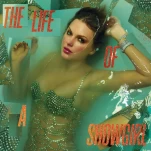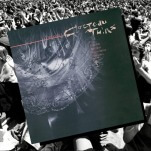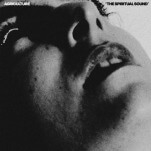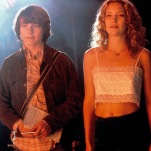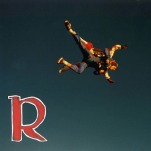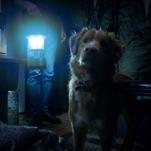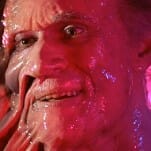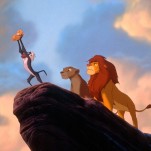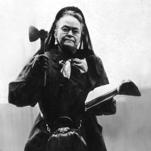In the Superb “Black Museum,” Black Mirror Looks at Its Own Reflection
(Episode 4.06)
Photo: Jonathan Prime / Netflix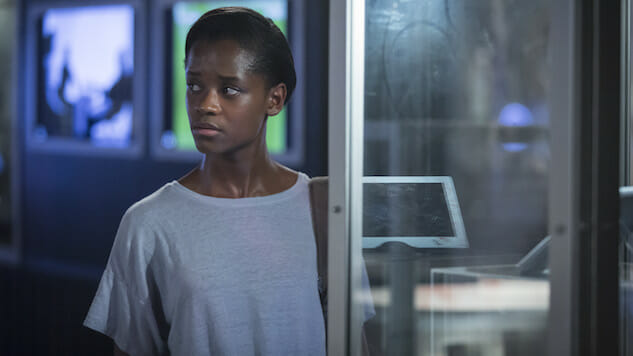
A Black Mirror episode about Black Mirror, “Black Museum” includes artifacts from previous episodes in the season, including the Arkangel tablet from “Arkangel” and the lollipop from “USS Callister.” An anthology whose conclusion fulfills some of the audience’s most spiteful desires when it comes to the sometimes relentlessly cruel Black Mirror, the episode follows a woman (Letitia Wright, unassuming and sharp) as she listens (watches) to stories (episodes) from its proprietor (a devilish Charlie Brooker if ever there was one).
This proprietor, Rolo Haynes (Douglas Hodge in a freewheeling, Used Car Salesman of the Apocalypse performance), takes her through the items—both in the museum and in the stories—like a horror host combo of Joe Bob Brigg, The Crypt Keeper, and quite possibly Satan.
The stories share a distraught despondency, in direct opposition to the hyper-stylish, The Shining-like opening. An overhead helicopter shot of a car distinct from its environment (there snow, here desert) and Dionne Warwick’s jazzy “Always Something There to Remind Me” playing on the radio set us up for this poor girl to experience Hell.
Here, however, she’s not a foolish author-cum-caretaker in charge of a haunted hotel. She’s just a motorist waiting on her solar panel to charge. She wanders into the museum to kill time—as many of us flip on Netflix—and receives spooky stories in return. The first, about a sensation-sharing neural implant used by a doctor for diagnostic purposes, dives headfirst into the episode’s (and series’) theory that all technology—no matter how just or pure—will inevitably be perverted. It’s just human nature, says Black Mirror. The internet, born of science and kinship, is now a haven for political deviants, unthinkable pornography and vloggers. The doctor, played with delightful abandon by Daniel Lapaine, is similarly corrupted, and the eventual collision of personal pleasure and the pain of strangers is bleak, dirty and darkly funny.
While Brooker’s script can often lay too much out in plain language, as if he transcribed a particularly insufferable cocktail party conversation, director Colm McCarthy creates some of the most striking and impactful images of the season. There are complex philosophical questions — “Can two people live inside of one person, with one consciousness in physical control?” asks the second installment in the meta-anthology — that are answered only with fruitful and provoking sequences of image projection, elegantly simple set design, and soft audience guidance. Leading us step by step are the distorted but effective sightlines of the characters on display here, whether they are corporeal or not. Establishing that cinematographic narrative structure isn’t easy, especially when the story is as inherently loose as this, but McCarthy finds solidity in his consistent construction.
As the stories go on, they become darker and darker, with the torturous technological aspects becoming more and more sadistic. As if the pain-to-pleasure stuff wasn’t bleak and gory enough, what about the soul-binding entrapment of a (possibly) innocent man? The devil-dealing comparison grows more and more comprehensive as the episode goes on. Never sign anything, especially if offered by a sweaty man in a vest.
The episode’s climax, stumbling as it is, still provides enough comeuppance that it seems like Brooker and crew understand a segment of their viewership’s exhaustion with their techno-torture porn. This again comes primarily through some clever visual effects, prop creation and utilization, and the dynamic between Hodge and Wright as their relationships turns from unassuming to cat-and-caught-mouse—like the final turn of Jack Torrance. Where The Shining had a typewriter, the fax machine of evil, this has a stuffed bear and a Green Mile-like electric chair. Stephen King’s strengths and weaknesses pervade the episode, but if a horror anthology is going to make a self-reflexive iteration, he’s not a bad starting point. The dialogue can get clunky and the ideas are communicated so well visually that the already redundant script seems to get in its own way even more, but those ideas potent enough that I’ll never dissociate Black Mirror from the grim specter of a museum carny.
Read all of Paste’s episodic reviews of Black Mirror here.
Jacob Oller is a writer and film critic whose writing has appeared in The Guardian, Playboy, Roger Ebert, Film School Rejects, Chicagoist, Vague Visages, and other publications. He lives in Chicago, plays Dungeons and Dragons, and struggles not to kill his two cats daily. You can follow him on Twitter here: @jacoboller.
